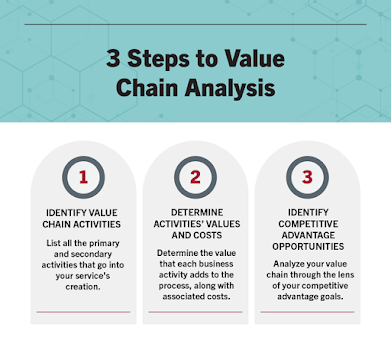08. Unveiling the Value Chain Analysis for Effective Talent Management
For your business to grow, you need to provide your customers with value or risk losing business to competitors. How do you know if your product or service is providing customer value? It’s not always easy to identify. So here is a solution to this problem, it is the value chain analysis.
What is value chain analysis?
Value chain analysis is a means of evaluating each of the
activities in a company’s value chain to understand where opportunities for
improvement lie.
Conducting a value chain analysis prompts you to consider how each step adds or subtracts value from your final product or service. This, in turn, can help you realize some form of competitive advantage, such as,
- Cost reduction, by making each activity in the value chain more efficient and, therefore, less expensive,
- Product differentiation, by investing more time and resources into activities like research and development, design, or marketing that can help your product stand out.
Typically, increasing the performance of one of the four
secondary activities can benefit at least one of the primary activities.
How to conduct a value chain analysis?
Value chain analysis for effective talent management
The purpose of analyzing the value chain of
talent-management process is to identify how each business activity within the
process contributes to the overall
competitive strategy and where there may be efficiencies and cost savings to be
gained within the process.
An organization may create a cost advantage through
value-chain analysis by reducing the cost of the individual activities within
the value chain or by reconfiguring the value chain.
Steps of value chain analysis for effective talent management
- Identify
or clarify your overall competitive strategy: This may mean
revisiting your vision and/or mission, or reiterating the firm’s
short-term and long-term goals, ensuring that everyone within all
departments in the organization is on the same page.
- Activity
analysis: Identify each activity undertaken in the
talent-management process (recruiting, hiring, retaining and growing of
human capital). This can be accomplished by conducting a brainstorming
session or a business process review (BPR) with key individuals who are
responsible for carrying out these activities and those who are impacted
by these activities.
- Value
analysis: For each activity, assess the value that the activity
brings to the process. Evaluate the pros and cons of making changes to the
process. You must also consider how the changes may affect other
departments within the organization and evaluate the overall impact of
proposed changes.
- Planning: Design
and implement a strategic plan to reduce the costs of the activities
within the talent-management value chain or the cost to reconfigure the
value chain.
Advantages of value chain analysis
· Cost savings in the forms of process efficiency,
reduced employee turnover and excellent customer service leading to increased
market share and customer loyalty.
· Gives the organization the ability to identify how each business activity within an internal value chain contributes to the organization’s competitive strategy, creating synergy between departments and making the strategy more systemic overall.
In conclusion, the value chain analysis for effective
talent management is not merely a theoretical concept but a practical roadmap
for organizations aspiring to thrive in the competitive landscape. It beckons
leaders to recognize that talent is not just a resource; it is the driving
force that propels the organization forward. By embracing this approach,
organizations can unlock the full potential of their human capital, creating a
workforce that is not only capable of meeting the challenges of today but poised
to shape the opportunities of tomorrow. As we navigate the ever-evolving
landscape of work, unveiling the power of value chain analysis in talent
management is the compass that guides organizations toward sustained success
and resilience.
References
1.
Stobierski, T., 2020. What is a value chain
analysis? 3 steps: HBS Online (2020) Business Insights Blog.
Available at: https://online.hbs.edu/blog/post/what-is-value-chain-analysis
(Accessed: 07 December 2023).
2.
Zmorenski, D. (2013) Using value-chain analysis for
effective talent management, Reliable Plant. Available at:
https://www.reliableplant.com/Read/29326/value-chain-analysis (Accessed: 07
December 2023).
3.
Jurevicius, O. (2023) Value Chain Analysis: The
ultimate guide - SM insight, Strategic Management Insight. Available
at: https://strategicmanagementinsight.com/tools/value-chain-analysis/
(Accessed: 07 December 2023).


How does value chain analysis contribute to cost savings in talent management, according to the provided information?
ReplyDeleteHi Pandula, Thank for your feedback. As per the above blog value chain can be contribute to cost saving by forming process efficiency in order to reduce employee turnover. There is a hidden cost in recruiting employees.
DeleteThe value chain concept was first described in 1985 by Harvard Business School professor Michael Porter, in his book Competitive Advantage: Creating and Sustaining Superior Performance. Basically , The value chain framework helps organizations identify and group their own business functions into primary and secondary activities. Pandula has inquired How does value chain analysis contribute to cost savings in talent management. According to my view it can help to Negotiate lower prices for raw materials, equipment, and other services. Through the value chain organizations can achieve a significant cost advantage over their competitors, improve profitability, and ultimately achieve their strategic goals. what is your idea?
ReplyDeleteThank you, Mahesh for your feedback, yes true you can achieve their strategic goals through value chain analysis through cost advantage over their competitors and also by improving profitability.
ReplyDeleteThrough the value analysis organizations can find areas for efficiency improvements and cost reductions. The same concept can be applied to Talent Management. It will improve employee performance and guarantee alignment with strategic objectives.
ReplyDeleteYes agree. There are areas where organizations can use value chain analysis as mentioned above.
Delete